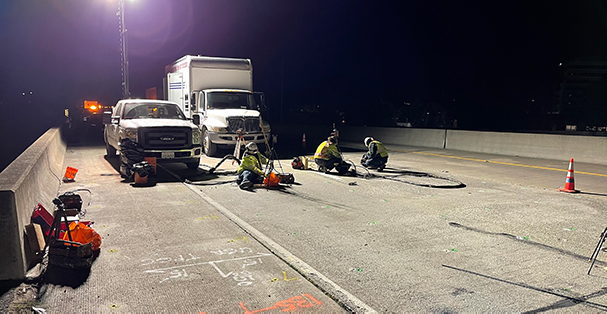Bridge Transition Slabs
Bridge transition slabs are an important structure that ensure a smooth approach and departure onto and off a bridge. When transition slabs settle, the issue can cause many problems such as uneven slabs, damage to vehicles, and damage to the roadway and bridge. The challenge for transportation departments and engineers is the task of repairing the bridge transition without dramatically impacting the community by causing significant delays to operations. This article discusses how geotechnical polyurethane may be the right solution for achieving these repairs by balancing timeliness, longevity of repair, and cost.
One of the main causes of bridge transition settlement stems from a failure in the bridge abutment that allows the loss of the structural fill that is meant to support the approach slab. From continuous vibration and erosion from rain events, the fill begins to subside and weaken to a point where it is no longer adequately supporting the transition slab. This can result in voids to form and settlement to occur.
There are a variety of Highway infrastructure applications polyurethane can be used for.
Here are a few examples:
-
Bridge Transition Realignment
-
Roadway Leveling
-
Road Base Stabilization
-
Manhole Soil Stabilization
-
MSE Wall Stabilization
-
Void Filling
-
Culvert Repair
Geotechnical Polyurethane Injection
This is where geotechnical polyurethane injection comes in. Geotechnical polyurethanes, such as EagleLIFT’s EL Polymers, are highly dense, light-weight polymers that are specially formulated to interact with and densify weak soils. This process restores the load-bearing capacity of the soils, and also stabilizes them against future erosion.

Deep Stratum Injection
When it comes to bridge transitions, the process is highly effective because it is fast and minimally impacts the slab. Through a hole no bigger than a dime, we are able to access the weak soil underneath the slab. We use a multiple-depth gridded injection approach called Deep Stratum Injection, where we densify the soil at depth. We are then able to use the polyurethane to lift and level the approach slab to grade. The polyurethane quickly cures to 95% capacity within 25 minutes, allowing for a fast repair that can be typically completed during non-peak hours.
So with a single application, a bridge transition can be stabilized and leveled within hours!
EagleLIFT has a long history of working with Transportation departments throughout California, Arizona, and Nevada. We have the safety procedures, licenses, insurance, and work history in place to help any engineer or department get their projects completed quickly and cost effectively. If you have any projects you’d like us to look at, contact us today!

